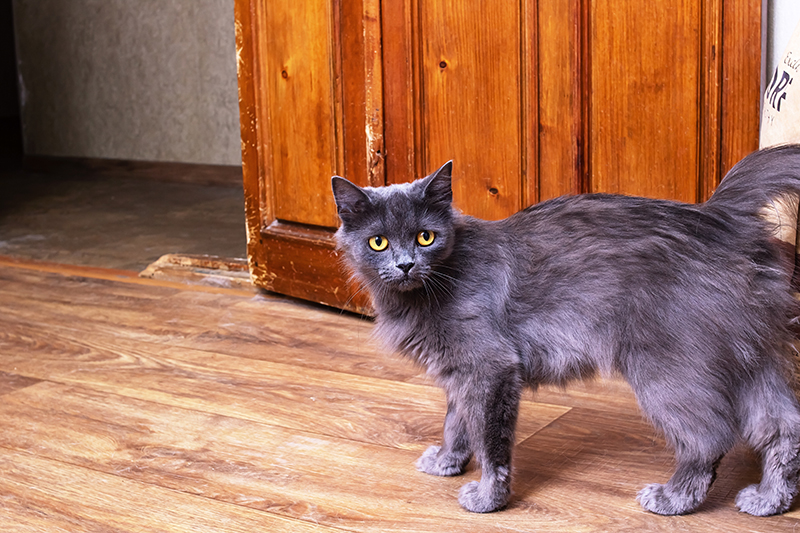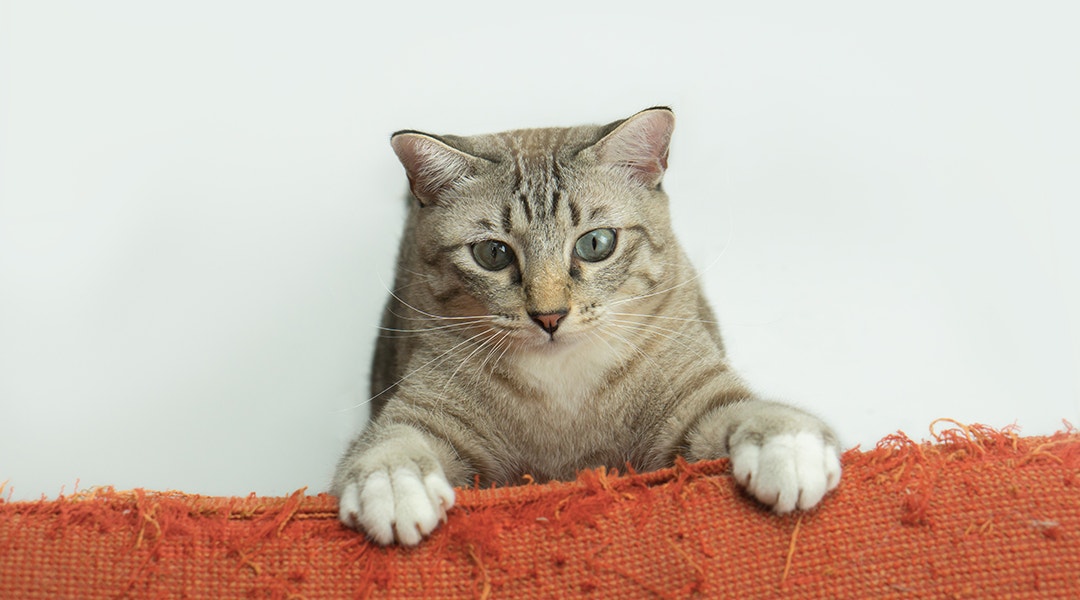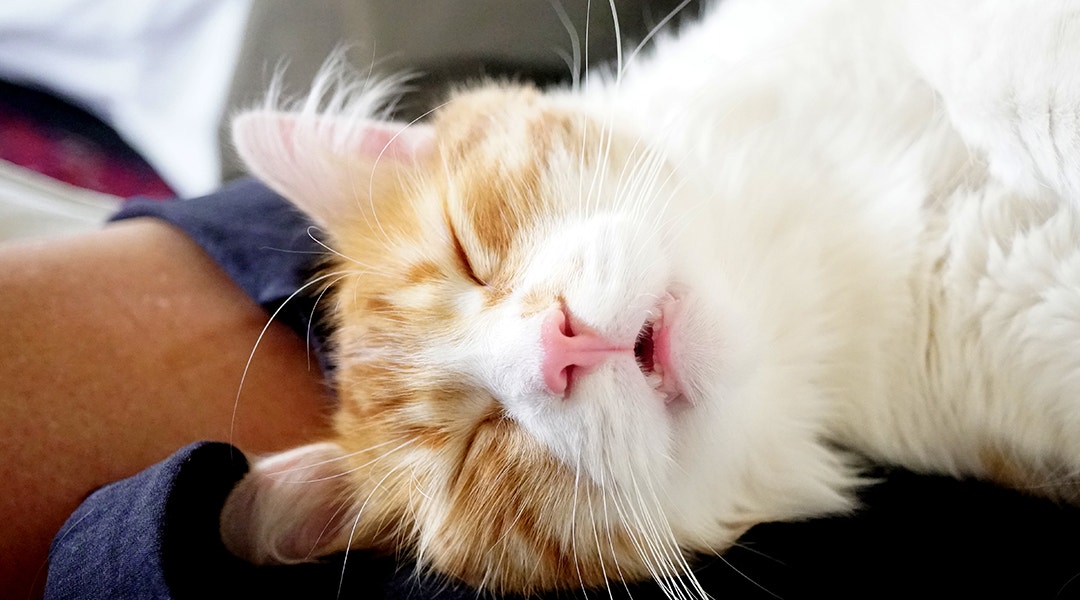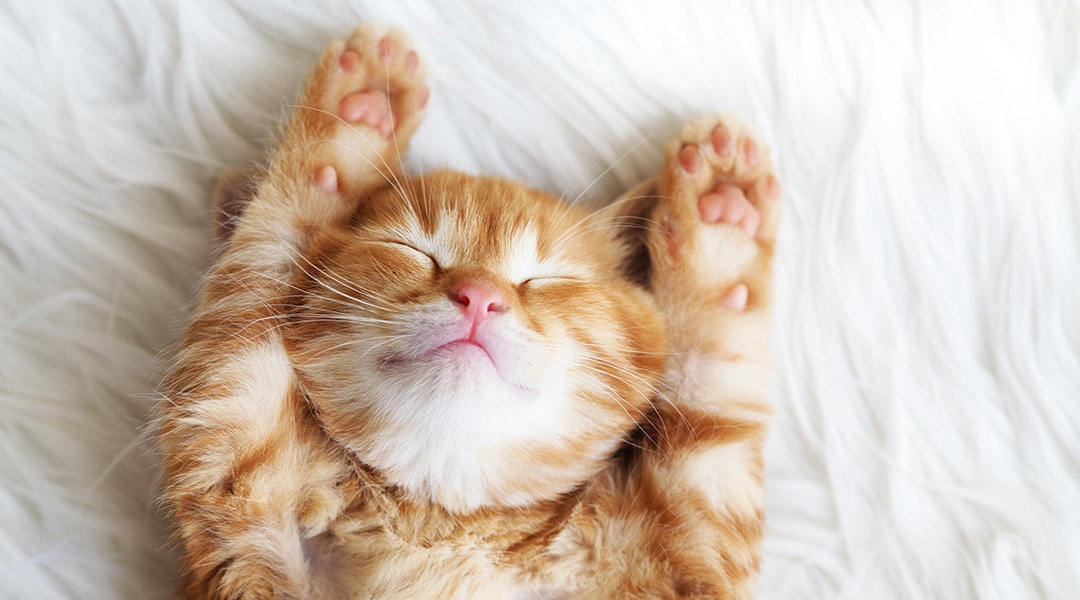Cats are territorial animals and tend to use a variety of methods to communicate with humans, as well as other cats. One of the ways they do this is through scratching. Scratching is a healthy and natural instinct for cats, and it’s important to understand this behaviour. However, it can be destructive as well as disruptive, especially at night. Training can help stop your cat scratching at night.
In this article, we discuss how to stop your cat scratching the carpet, door and furniture. We look at why cats scratch and what it means, as well as how to modify the behaviour. By supporting your cat’s scratching instincts with appropriate outlets and saving your furnishings from damage, you can improve the bond between you and your cat.
Why do cats scratch?
There are many instinctual reasons behind why cats scratch. As we know, scratching is a natural cat behaviour, rather than a misbehaviour. Some of the instinctual reasons behind scratching include maintaining their claw health, stretching their bodies, marking their territory and expressing their emotions. We discuss each of these reasons further below.
Whatever the reason your cat is scratching, it’s important to be understanding of this behaviour. Your cat isn’t scratching the carpet to misbehave deliberately, but simply engaging in their natural instincts. With patience and compassion, you can address this issue effectively and strengthen your relationship with your cat.
What does it mean when a cat is scratching?
As mentioned, cats use scratching to maintain their claws, mark their territory, stretch their bodies and express their emotions.
Communication
Cats may scratch as a way to express their emotions, just like their other behaviours (for example, if a cat is hissing, it indicates that they’re feeling defensive). If you’re wondering why your cat is scratching your door at night, they could be feeling anxious or bored at being left alone, seeking attention and inviting you to play with them. On the other hand, they could be showing excitement or releasing pent-up energy.
Territory
One of the main reasons for scratching is for cats to mark their territory. Your cat’s paw pads contain scent glands, and as they scratch, they can leave behind their individual smell. This serves as a physical and chemical message to other cats, and helps your cat feel more secure.
Hygiene
As cats scratch, the outer old and dead sheaths of their claws are removed, making it a part of their grooming routine. This helps cats keep their claws healthy and sharp, which is important for when they’re climbing, exploring or if they need to defend themselves.
Stretching
Scratching is also a way for cats to stretch their bodies, especially their back muscles, and maintain their flexibility. It’s common for cats to stretch before or after a nap, and important for their overall well-being, as well as to relieve stress.
Negative effects of indoor scratching
However, if done inappropriately, there can be negative effects of indoor scratching:
- Damaged furniture: If your cat is scratching your furniture, like your chairs, sofas and other wooden items, it can cause a lot of damage and lead to costly repairs or replacements, which can be stressful.
- Ruined carpets: Cats can enjoy the texture of carpets and rugs, so if you’re wondering why your cat is scratching the carpet, that’s probably why. However, this can cause fraying and damage your carpet over time.
- Scratched doors: Some cats prefer to scratch vertically, which could be why your cat is scratching doors. This can affect paintwork and leave unsightly marks on the door.
- Strained relationships: With your cat damaging your home, you may begin to feel frustrated or even resentful towards your cat. This can affect your relationship and cause tension.
- Cat anxiety: Since your cat's scratching the carpet, as well as other things, can be stressful, you might end up raising your voice, which can contribute to their anxiety and worsen the situation.
Provide acceptable outlets for scratching

In order to stop your from cat scratching doors, you’ll need to provide acceptable outlets for their scratching needs. Depending on what your cat is scratching, you’ll be able to tell what type of scratching surface your cat needs: vertical, horizontal, sisal, cardboard, etc. If they’re scratching doors, they’d likely enjoy a vertical scratching post, perhaps with a cardboard texture. On the other hand, if you’re wondering why your cat is scratching your carpet, it’s likely because they need a horizontal scratching post that is made of sisal rope.
It’s helpful to place a variety of scratching outlets in places where your cat usually likes to scratch, whether it’s near certain furniture, the window, or your cat’s sleeping areas. This will make it easier for you to redirect them to the appropriate outlet instead. Having scratching posts or pads near where your cat sleeps will encourage them to use them for post-nap stretching, too! Check out how to make a DIY cat tree to help stimulate your cat.
How to discourage undesirable scratching
While it’s crucial to understand the reasons why your cat is scratching furniture, it’s also important to discourage undesirable scratching behaviours. There are many safe deterrents that you can place around the house to stop your cat from scratching at night. For instance, you can place double-sided tape or aluminium foil around the furniture, since cats don’t like these textures. If this doesn’t work, you could use furniture covers to protect the entire surface. Pet-safe deterrent sprays also leave a scent that cats don’t like and may put them off.
Just as deterrents are useful, providing plenty of scratching alternatives is also effective. This will make it easier for you to gently redirect your cat to a more appropriate outlet. This could also be when to give your cat a treat, to reinforce the desired behaviour. We discuss behaviour modification and training tips further below.
However, it’s crucial to note that you shouldn’t declaw your cat as a solution, as this is not only traumatic but also harmful. Your cat needs their claws to navigate their environment and protect themselves in conflict, although it’s helpful if you trim them regularly yourself too. You must avoid harsh punishment, which will cause anxiety and stress in your cat and negatively affect your relationship. Make sure your cat is receiving enough mental stimulation and physical exercise to avoid destructive behaviours.
Behavior modification & training tips
In order to train your cat to stop scratching furniture, you can use positive reinforcement training. When gently redirecting your cat to a scratching post or pad, you can reinforce their appropriate use of it with praise and treats. Every time they scratch an acceptable outlet, offer plenty of verbal praise and reward them with treats so they create positive associations with desirable behaviours. In fact, this is similar to how you’d litter train a kitten, or with cat flap training.
Patience is also a key part of training, and you’ll need to have plenty of it. Your cat will respond well to behaviour modification if you are consistent in setting daily routines and using the same cues to help familiarise them. If you notice that your cat’s scratching is new or excessive, try to identify if there are stressful triggers. It could be a change in their environment, such as a new pet or person, loud noises or lack of stimulation. Once you know what it is, you can reduce the triggers and provide a calmer environment.
When to seek help
If, despite your training, you can’t understand why your cat is still scratching your carpet, there may be another issue at hand. There are some concerning signs to look out for, such as if your cat’s scratching becomes excessive or obsessive without an obvious trigger. There may also be other signs, such as your cat over-grooming themselves, becoming aggressive, or changing their eating or litter box habits. In these cases, it could indicate your cat is experiencing anxiety or stress, or possible discomfort and pain from a health issue.
It’s important to consult a veterinarian if your cat continues to scratch inappropriately, even with scratching outlets and positive reinforcement training. This way, your vet can check for any medical conditions. If it’s not a health issue, an animal behaviourist can help identify if there are emotional triggers and provide behaviour training for your cat’s well-being.
Conclusion - stop cats from scratching
To reiterate, it is absolutely normal for cats to scratch. However, they will need encouragement and training to manage this behaviour in a way that meets their needs while also protecting your home. To stop your cat from scratching the carpet, furniture or door, you’ll need to take three simple steps.
First, deter your cat from scratching your belongings, then provide an acceptable outlet, and finally reward them for using this instead. With patience and understanding, as well as using DREAMIES™ treats, you can help manage your cat’s scratching behaviours.
FAQ - Cat scratching
How do I get my cat to stop clawing the carpet?
To stop your cat from clawing and scratching the carpet, you can use safe deterrents like sticky tape or silver foil in those areas. Instead, provide appealing scratching posts nearby and reward your for cat using them with treats and plenty of praise as encouragement and reinforcement of the desired behaviour.
What can I spray on my carpet to keep my cat from scratching it?
To stop your cat from scratching the carpet, you can use pet-safe deterrent sprays that are designed with scents that cats tend to dislike. This will help put your cat off from using those areas. It’s important to avoid harsh chemicals that can be harmful to your cat or belongings.
How do I protect my carpet from cat scratches?
You can protect your carpet from cat scratches by using safe cat deterrents, such as sticky tape, sprays and covers. Instead, provide appropriate scratching outlets near your cat’s favourite areas to stop your cat from scratching the carpet. You can also trim your cat’s nails to reduce damage.
How to fix carpet scratched by a cat?
If your carpet has been scratched by a cat, it is possible to fix it. It’s best to trim the loose carpet fibres carefully with scissors. Then, you can vacuum the area to revive the carpet. In more extreme cases, you may need a carpet repair kit or a professional cleaning.





